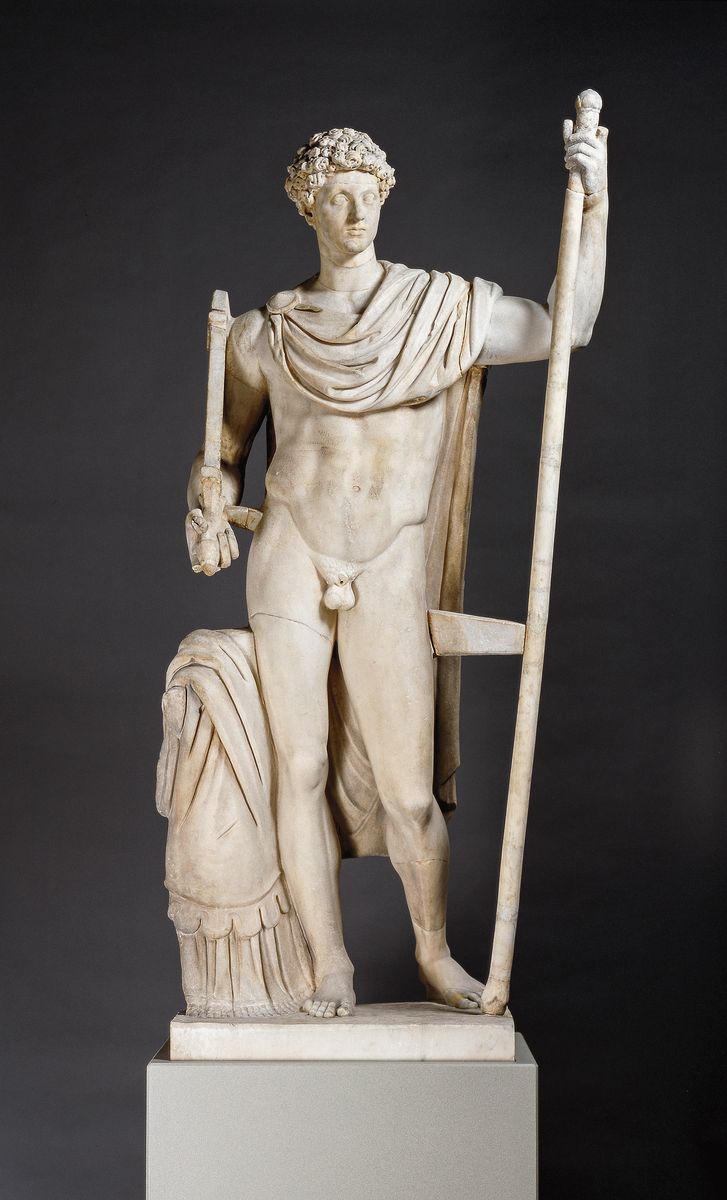Portrait of Marcus Aurelius
Place found:Italy
Culture: Roman
Date: ca. 140-150
Medium: Marble
Dimensions:
height: 94 7/8 in. (241 cm)
width (plinth): 32 1/2 in. (82.6 cm)
depth (plinth): 26 3/8 in. (67 cm)
Credit Line: San Antonio Museum of Art, gift of Gilbert M. Denman, Jr.
Object number: 85.136.1
Provenance: excavated by Gavin Hamilton (1723-1798) at Tor Colombaro, near Frattocchie, Italy, 1771; sold by Gavin Hamilton to William Petty-Fitzmaurice, second earl of Shelburne, first marquess of Lansdowne, (1737-1805), London, 1773; acquired from the estate of William Petty-Fitzmaurice by John Henry Petty-Fitzmaurice, second marquess of Lansdowne (1765-1809), London; by inheritance to Mary Arabella Petty, marchioness of Lansdowne (d. 1833) London, 1809; sold by Mary Arabella Petty to Henry Petty-Fitzmaurice, third marquess of Lansdowne (1780-1863), London, 1810; by inheritance to Henry Thomas Petty Fitzmaurice, fourth marquess of Lansdowne (1816-1866), London, 1863; by inheritance to Henry Charles Petty-Fitzmaurice, fifth marquess of Lansdowne (1845-1927), London, 1866; by inheritance to Henry William Edmund Petty-Fitzmaurice, sixth marquess of Lansdowne (1872-1936), Wiltshire, 1927; Christie's, London, March 5, 1930, lot 17 (unsold); by inheritance to Charles Hope Petty-Fitzmaurice, seventh marquess of Lansdowne (1917-1944), Wiltshire, 1936; by inheritance to George John Charles Mercer Nairne Petty-Fitzmaurice, eighth marquess of Lansdowne (1912-1999), Wiltshire, 1944; sold, Sotheby's, London, December 4, 1972, lot 127 to Gilbert M. Denman, Jr. (1921-2004), San Antonio; Gilbert M. Denman, Jr., by gift to San Antonio Museum of Art, 1985
Published References
J. Dallaway, Anecdotes of the Arts in England (1800), 340.
F. Clarac, Musée de Sculpture (1839-1841), vol. 5, no. 2445a, plate 950
G. Waagen, Treasures of Art in Great Britain (1854), ii, 149.
A. Michaelis, "Die Privatsammlungen antiker Bildwerke in England," Archäologische Zeitung 32 (1874) 37, no. 37.
A. Michaelis, Ancient Marbles in Great Britain (Cambridge: Cambridge University Press, 1882), 453, no. 63.
A. H. Smith, A Catalogue of the Ancient Marbles at Lansdowne House (London: Woodfall & Kinder, 1889), 10, 28-29, no. 63, 65-68
A. Furtwängler, Meisterwerke der griechischen Plastik: Kunstgeschichtliche Untersuchungen (Leipzig and Berlin, 1893), p. 126
A. Furtwängler, Masterpieces of Greek Sculpture: A Series of Essays on the History of Art (London, 1895), p. 92 n. 4.
S. Reinach, Répertoire de la statuaire grecque et romaine (Paris, 1897), vol. 1, p. 585, pl. 950, no. 2445a
A. T. Bolton, The Architecture of Robert and James Adam 1785-1795 (London, 1922), vol. II, 6, 15f. [photos of the statue in Lansdowne House]
F. Muthmann, Hadrianische und antoninische Statuenstützen: Beiträge zur Geschichte der römischen Kopistentätigkeit (1927), 63.
P. Arndt & W. Amelung, Photographische Einzelaufnahmen antiker Skulpturen, (1929), nos. 3058-3059
"A Great Event in the World of Art: The Coming Dispersal of the Lansdowne Marbles," The Illustrated London News (Jan. 11, 1930), p. 52.
Christie's, The Celebrated Collection of Ancient Marbles in the Property of the Most Hon. the Marquess of Lansdowne (London, 5 March 1930), 15, no. 17.
M. Wegner, Die Herrscherbildnisse in antoninischer Zeit. Das römische Herrscherbild II 4 (1939), 179, pl. 16a, 17a.
C. C. Vermeule, III, "Notes on a New Edition of Michaelis: Ancient Marbles in Great Britain," American Journal of Archaeology 59 (1955) 131.
Sotheby's, London, sale catalogue, December 4th, 1972, p. 33, lot 127, pl. 25.
C. C. Vermeule, III, Greek Sculpture and Roman Taste (Ann Arbor: University of Michigan Press, 1977), 67-68, fig. 61.
M. Wegner, Verzeichnis der Kaiserbildnisse von Antoninus Pius bis Commodus I, in Boreas 2 (1979), 142
C. A. Picón, "Ancient Art from the Denman Collection," San Antonio Museum Association Quarterly (Winter 1987), 12.
R. Neudecker, Die Skulpturenausstattung römischer Villen in Italien (Mainz: von Zabern, 1988), 189, no. 38.1.
E. Flisi, Questioni di ritrattistica antoniniana. Dalla collezione del Palazzo Ducale di Mantova (Florence, 1989), 28 n. 59.
San Antonio Museum of Art, The First Ten Years (San Antonio, 1990), 75.
K. Fittschen, Prinzenbildnisse antoninischer Zeit. Beiträge zur Erschließung hellenistischer und kaiserzeitlicher Skulptur und Architektur 18. (Mainz: von Zabern, 1999), no. B5, 22-23, 29, pl. 28.
C. H. Hallett, The Roman Nude: Heroic Portrait Statuary, 200 BC-AD 300 (Oxford: Oxford University Press, 2005), 182, 323, no. B158.
R. R. Brettell & C. D. Dickerson, III, eds., From the Private Collections of Texas: European Art, Ancient to Modern (Fort Worth: Kimbell Art Museum, 2009), 34, fig. 29, 100.
I. Bignamini & C. Hornsby, Digging and Dealing in Eighteenth-Century Rome (New Haven: Yale University Press, 2010), 1:178-79.
B. Cassidy, The Life & Letters of Gavin Hamilton (1723-1798), Artist and Art Dealer in Eighteenth-Century Rome (London: Harvey Miller, 2011), letters 61, 62, 63, 144, 170, fig. 36.
J. Powers and J. Johnston, eds., San Antonio Museum of Art: Guide to the Collection (San Antonio: San Antonio Museum of Art, 2012), 50-51.
K. A. Raff, ed., Roman Art in the Art Institute of Chicago (online: publications.artic.edu/roman/reader/romanart/section/481), fig. 14.13.
E. Angelicoussis, Reconstructing the Lansdowne Collection of Classical Marbles (Munich: Hirmer, 2017), 2:218-225, no. 33.
C. Niederhuber, Roman Imperial Portrait Practice in the Second Century AD (Oxford University Press, 2022), 63 n. 43, 96 no. II.21.
Label Text
As a young man, Marcus Aurelius was adopted as the emperor Antoninus Pius’s chosen successor. This portrait depicts Marcus as a youthful prince, with the first traces of a beard and a head of rich curls. The imposing nude torso gives him a heroic appearance, enhanced by the military cloak draped around his shoulders and the sword and scepter he holds. Emperor from A.D. 160-181, Marcus spent much of his reign confronting invasions on the northern and eastern frontiers of the Empire. He also wrote a collection of philosophical reflections known as the Meditations.
This statue was found at a villa near Rome in 1771 by the Scottish antiquarian and art dealer Gavin Hamilton. Hamilton sold it to the first Marquess of Lansdowne, who assembled a large collection of Greek and Roman sculpture at his house in London. The statue was restored from several fragments in the late 1700s. According to Hamilton’s correspondence, the head was found near the body; scholars disagree over whether or not the head belonged to this statue in antiquity. (Jessica Powers, 2008)
This statue was found at a villa near Rome in 1771 by the Scottish antiquarian and art dealer Gavin Hamilton. Hamilton sold it to the first Marquess of Lansdowne, who assembled a large collection of Greek and Roman sculpture at his house in London. The statue was restored from several fragments in the late 1700s. According to Hamilton’s correspondence, the head was found near the body; scholars disagree over whether or not the head belonged to this statue in antiquity. (Jessica Powers, 2008)
On view
In Collection(s)
The San Antonio Museum of Art is in the process of digitizing its permanent collection. This electronic record was created from historic documentation that does not necessarily reflect SAMA's complete or current knowledge about the object. Review and updating of such records is ongoing.













 This resource has been made possible in part by the National Endowment for the Humanities: Exploring the Human Endeavor.
This resource has been made possible in part by the National Endowment for the Humanities: Exploring the Human Endeavor.
